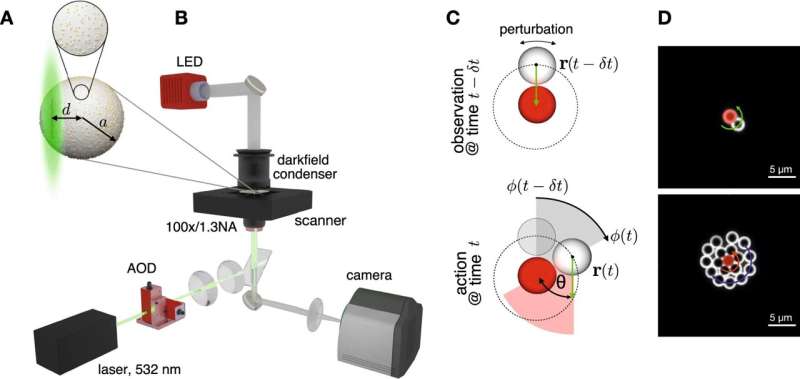This article has been reviewed according to Science X's editorial process and policies. Editors have highlighted the following attributes while ensuring the content's credibility:
fact-checked
peer-reviewed publication
trusted source
proofread
Laser-controlled synthetic microswimmers show swarm intelligence can be caused by physical mechanisms

Seemingly spontaneously coordinated swarm behavior exhibited by large groups of animals is a fascinating and striking collective phenomenon. Experiments conducted by researchers at Leipzig University on laser-controlled synthetic microswimmers now show that supposed swarm intelligence can sometimes also be the result of simple and generic physical mechanisms.
A team of physicists led by Professor Frank Cichos and Professor Klaus Kroy found that swarms of synthetically produced Brownian microswimmers appear to spontaneously decide to orbit their target point instead of heading for it directly. They have just published their findings in the renowned journal Nature Communications.
"Scientific research on herd and flock behavior is usually based on field observations. In such cases, it is usually difficult to reliably record the internal states of the herd animals," Kroy said. As a result, the interpretation of observations frequently relies on plausible assumptions as to which individual behavioral rules are necessary for the complex collective groups under observation.
Researchers at Leipzig University therefore developed an experimental model system of microswimmers that elicits properties of natural swarm intelligence and provides complete control over the individuals' internal states, strategies, and transformation of signal perception into a navigational reaction.
Thanks to a sophisticated laser heating system (see image), the colloidal swimmers, which are visible only under the microscope, can actively self-propel in a water container by a kind of "thermophoretic self-propulsion" while their travel is permanently disturbed in a random manner by Brownian motion.
"Apart from Brownian random motion, which is ubiquitous in microphysics, the experimental set-up provides complete control over the physical parameters and navigation rules of the individual colloidal swimmers and allows long-term observations of swarms of variable sizes," Cichos said.
According to Cichos, when just a very simple and generic navigation rule is followed identically by all of the swimmers, a surprisingly complex swarm behavior results. For example, if the swimmers are aiming at the same fixed point, instead of them gathering at the same place a kind of carousel can form. Similar to satellites or atomic electrons, the swimmers then orbit their attractive center on circular paths of varying heights.
The only "intelligent" behavioral rule required for this is that the self-propulsion responds to environmental perception with a certain time delay, which usually occurs in natural swarm phenomena from mosquito dances to road traffic anyway. It turns out that such a "delayed" effect alone is sufficient to form complex dynamic patterns such as the carousel described above.
"Physically speaking, each individual swimmer can spontaneously break the radial symmetry of the system and go into circular motion if the product of the delayed time and swimming speed is large enough," Kroy said. In contrast, the orbits of larger swarms and their synchronization and stabilization depend on additional details such as the steric, phoretic and hydrodynamic interactions between the individual swimmers.
Since all signal-response interactions in the living world occur in a time-delayed manner, these findings should also further the understanding of dynamic pattern formation in natural swarm ensembles. The researchers deliberately chose primitive and uniform navigation rules for their experiment. This allowed them to develop a stringent mathematical description of the observed phenomena.
In the analysis of the delayed stochastic differential equations used for this purpose, the delay-induced effective synchronization of the swimmers with their own past turned out to be the key mechanism for the spontaneous circular motion. To a large extent, the theory allows us to mathematically predict the experimental observations.
"All in all, we have succeeded in creating a laboratory for swarms of Brownian microswimmers. This can serve as a building block for future systematic studies of increasingly complex and possibly still unknown swarm behavior, and it may also explain why puppies often circle their food bowl when they are being fed," Cichos said.
More information: Xiangzun Wang et al, Spontaneous vortex formation by microswimmers with retarded attractions, Nature Communications (2023). DOI: 10.1038/s41467-022-35427-7
Journal information: Nature Communications
Provided by Leipzig University




















